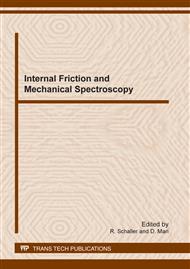p.42
p.52
p.63
p.69
p.75
p.81
p.87
p.92
p.98
Effects of Alloying Elements on the Oxygen Snoek-Type Relaxation in Ti-Nb Alloys
Abstract:
The effect of ternary alloying elements on the oxygen Snoek-type relaxation in the Ti-24Nb-2X-1.7O alloys (X = Al, Sn, Cr, Mn, Fe) was investigated. The dipole shape factor (δλ) of the Snoek-type relaxation was figured out for each ternary alloy based on the measured damping peak with the variable temperature. The value of δλ in the Ti-Nb-Al alloy was the highest among the present ternary alloys. It was found that δλ increased with the decreasing lattice constant as well as the decreasing valence electron number per atom (e/a) and came to a maximum value when the e/a value was around 4.24, which defined the β phase boundary. Therefore, decreasing the lattice constants and the e/a value as largely as possible with alloying elements in the β-Ti alloys is one of the feasible ways to increase δλ and to design the high damping Ti alloys.
Info:
Periodical:
Pages:
75-80
Citation:
Online since:
January 2012
Authors:
Price:
Сopyright:
© 2012 Trans Tech Publications Ltd. All Rights Reserved
Share:
Citation:


